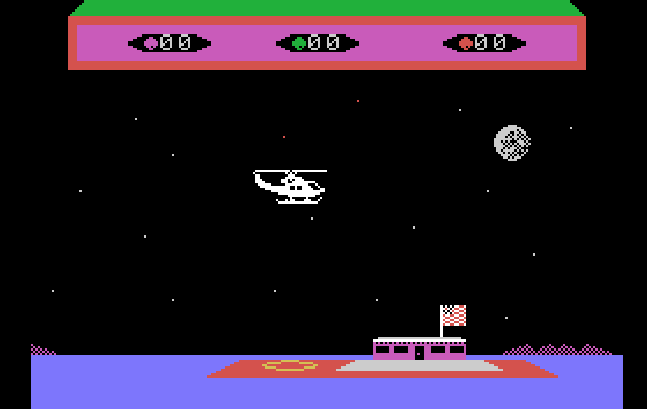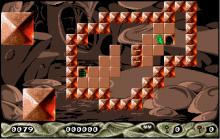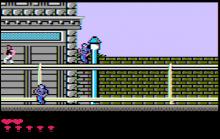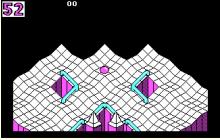Choplifter!
ColecoVision is mapped to use the number keypad on a full keyboard. If you don't have access to a keypad, you can press the TAB key and there is a menu that has options to change settings including remapping the keys. The default key mapping is in the chart bellow:

How to play Choplifter!
Each game uses different controls, Games can a combination of mouse,keyboard and Joystick.
Choplifter! Description
Choplifter (stylized as Choplifter!) is a 1982 Apple II game developed by Dan Gorlin and published by Brøderbund. It was ported to other home computers and, in 1985, Sega released a coin-operated arcade game remake, which in turn received several home ports of its own. While many arcade games have been ported to home computers and consumer consoles, Choplifter was one of the few games to take the reverse route: first appearing on a home system and being ported to the arcade.
In Choplifter, the player assumes the role of a combat helicopter pilot. The player attempts to save hostages being held in prisoner of war camps in territory ruled by the evil Bungeling Empire. The player must collect the hostages and transport them safely to the nearby friendly base, all the while fighting off hostile tanks and other enemy combatants. According to the backstory, the helicopter parts were smuggled into the country described as "mail sorting equipment."
Although the Iran hostage crisis ended the year before the game was released, Gorlin has stated "the tie-in with current events was something that never really crossed my mind until we published.
Choplifter was developed in six months. After Gorlin began experimenting with animating a helicopter on the Apple II, he added scenery, tanks, and planes, with the hostages last. He stated that as "A story developed ... movie camera techniques seemed appropriate", including the final message be "The End" instead of "Game Over". Gorlin's first demonstration to Broderbund was "too realistic, too much a helicopter simulation", and the company helped him make it easier to fly. The original Choplifter art (not shown) for the Broderbund Commodore 64 release was produced by Marc Ericksen, who created the art for Broderbund's original first five covers.
The helicopter (named "Hawk-Z" in the Master System version manual) can face three directions: left, right, or forward (facing the player). It may shoot at enemies in any of these directions and need not fly in the same direction it is facing. The forward-facing mode is used primarily to shoot tanks. Care must also be taken to both protect the hostages from enemy fire and not accidentally shoot them oneself.
The player rescues the prisoners by first shooting one of the hostage buildings to release them, landing to allow the prisoners to board the sortie, and returning them to the player's starting point. Each building holds 16 hostages, and 16 passengers can be carried at a time, so several trips must be made. When the chopper is full, no more hostages will attempt to board; they will wave the helicopter off and wait (hopefully) for its return. Usually, each trip back is more risky than the previous one since the enemy is alerted and has deployed a counter-attack.
If the player lands directly on top of a hostage, or completely blocks the building exit, the hostage(s) will be killed. In the Apple II and Atari 7800 versions, hostages will also die if the vehicle is not landed correctly (it is slightly tilted), being crushed as they attempt to board the chopper. While grounded, the helicopter may be attacked by enemy tanks, which it can shoot at only by returning to the air. Also, the enemy scrambles jet fighters which can attack the vehicle in the air with air-to-air missiles or on the ground with bombs.
Choplifter was ported to many other home systems of the era. These versions were ports of the original Apple II game, not the later arcade version. These systems include the Atari 5200, Atari 7800, Atari 8-bit family (and a graphically updated version for the Atari XEGS), ColecoVision, Commodore 64, Commodore VIC-20 and MSX. German publisher Ariolasoft published the European Commodore 64 version.
In 1985, Sega, looking for properties marketable in the west, produced remakes of Choplifter and Pitfall II on their System 8 hardware. Sega's version added scoring elements, music, a fuel gauge, and several new environments including a naval battle, a cave, and futuristic city. This version was also notable at the time for its heavy use of parallax scrolling.[3]
In 1986, ports of the arcade version back to home versions were developed for the Nintendo Entertainment System and Sega Master System. These versions include some gameplay and scoring changes of their own, but use the environments, music, and approximate scoreplay of the arcade remake. The arcade version is listed in the Killer List of Videogames Top 100 and one of the four best games in 1985.
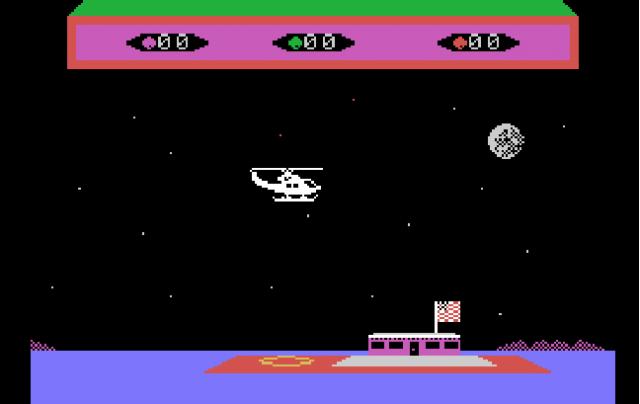
Choplifter! - additional information








